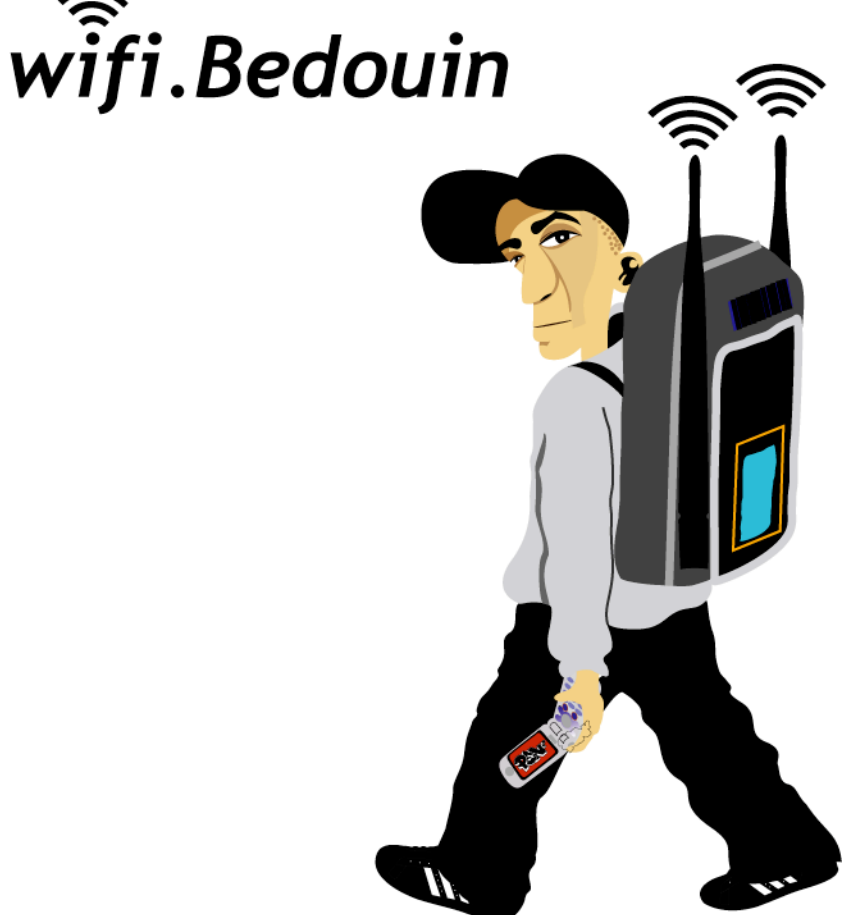
Project Summary
Project Semantic Tags
ART+TECHNOLOGYMARSHALL MCLUHANPROTOTYPEWIFI

WiFi.Bedouin Julian Bleecker http://julianbleecker.com julian (at) techkwondo.com
With the proliferation of “WiFi” networks and the mobile devices that access them, the public and private space surrounding us has become literally soaked through with Internet data. The promise of ubiquitous access to the Internet from anywhere, anytime is quickly being fulfilled.
WiFi.Bedouin is a wearable, mobile 802.11b node disconnected from the global Internet. It forms a WiFi “island Internet” challenging


conventional assumptions about WiFi and suggesting new architectures for digital networks that are based on physical proximity rather than solely connectivity. Most significantly, WiFi.Bedouin facilitates the creation of a truly mobile web community.
This project is designed to be functional as well as provocative, expanding the possible meaning and metaphors about access, proximity, wireless and WiFi. This access point is not the web without wires. Instead, it is its own web, an apparatus that forces one to reconsider and question notions of virtuality, materiality, displacement, proximity and community. WiFi.Bedouin is meant to suggest that what are often considered two entirely separate realms - virtual and physical worlds - are actually a much more entangled hybrid space.
Scenarios
WiFi.Bedouin is typically brought to an area where one expects to find an 802.11 “access point” or “Hot Spot.” As the unit advertises itself as a typical access point, with its own configurable “SSID” – or name – users with WiFi devices are more likely to notice a new node and investigate its level of access.
There are a myriad of possible ways to use the WiFi.Bedouin. The more interesting ones straddle the border between actions that are oppositional provocations and ones that are more whimsical, narrative-based experiences.
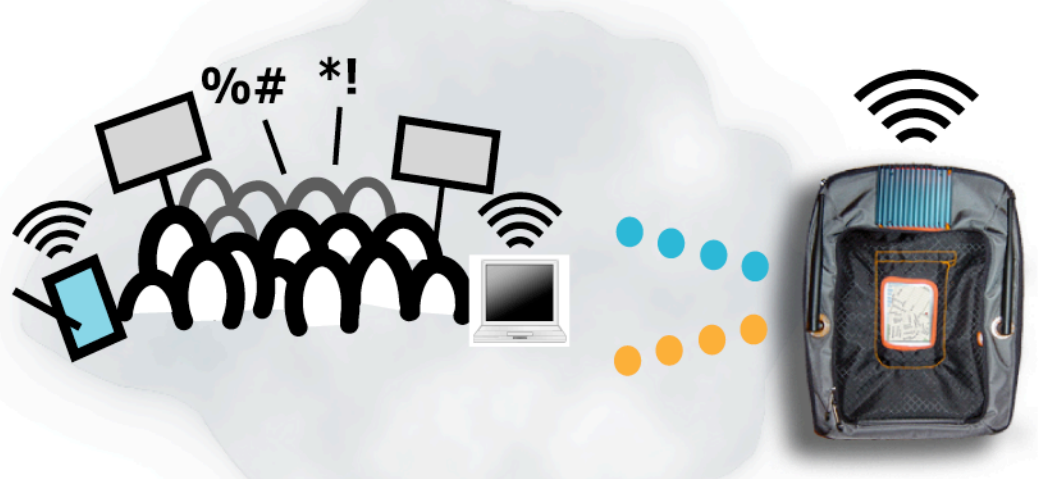
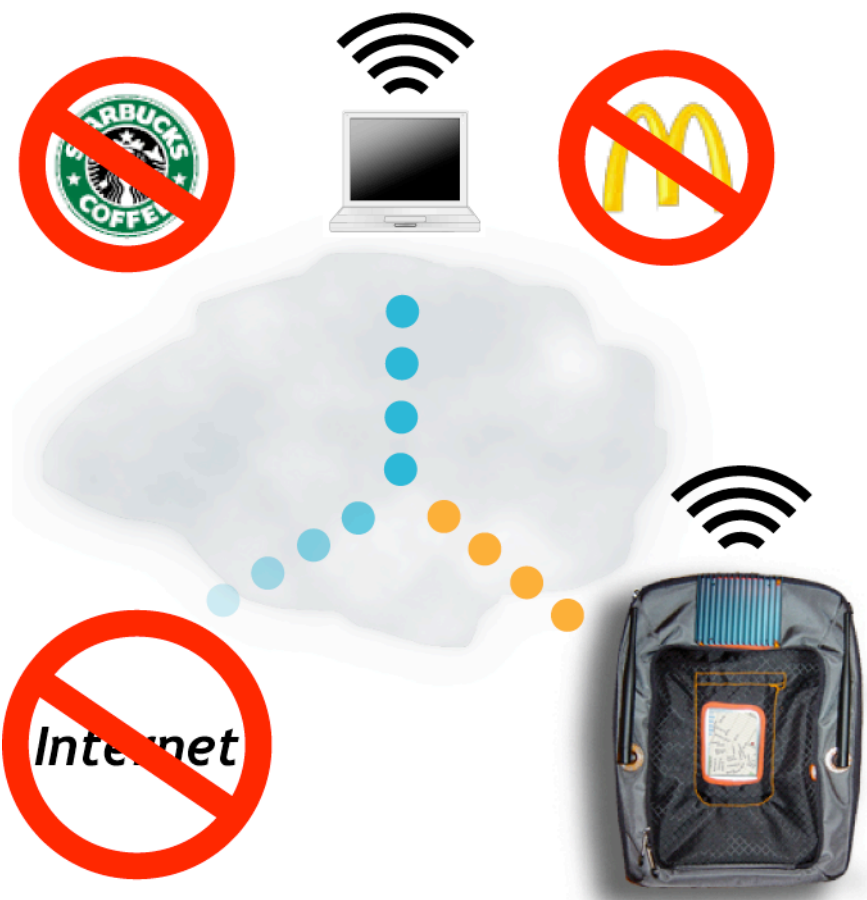
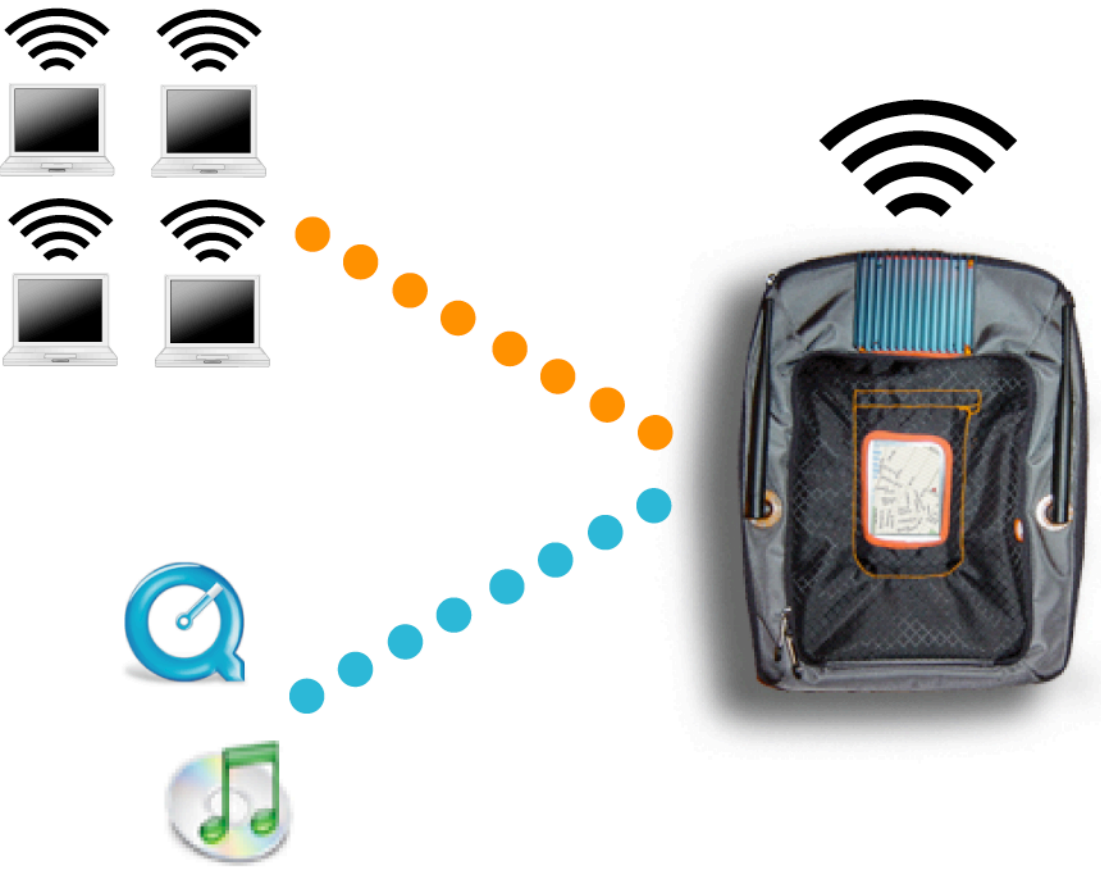
By default, WiFi.Bedouin has typical “groupware” applications such as chat, an open Blog to which users may post articles or comment on others’ articles, and iTunes Music Streaming.
Two WiFi.Bedouin applications are:
-
- SSID Stories. In this scenario, the node is named (its “SSID”) in a provocative way that forms the title of a short narrative. “My Girlfriend Can Surf..” might be the network name. When a user connects and attempts to surf to a web site, they instead receive a series of pages that tell the rest of the surfing girlfriend story, presented as a Flash animated narrative, or dynamic web site.
-
- Geo URL. This scenario pokes fun at the proprietary nature of “dot com” URLs by presenting to users entirely unexpected content for the URLs they enter in their browser. The application has spoof pages of the more popular web sites, all meant to compel uses to consider what a location specific web might be like. For instance, Google.com is presented as “Perry Street Google.com.”
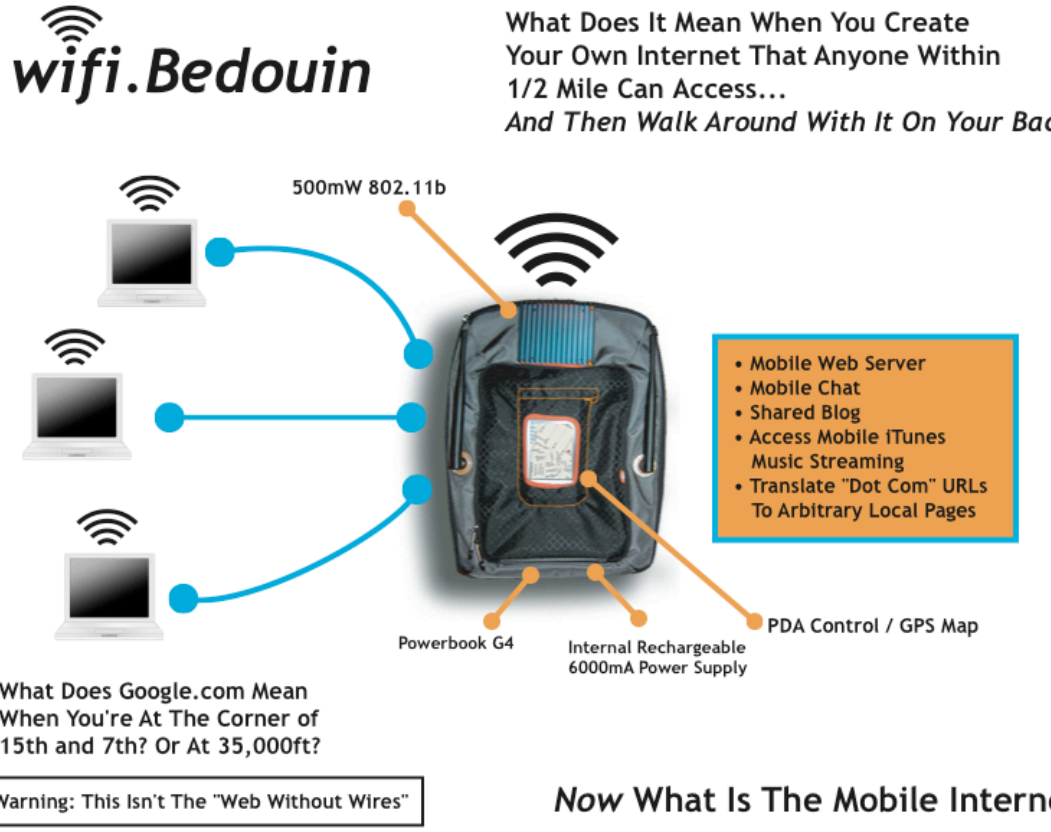
- Geo URL. This scenario pokes fun at the proprietary nature of “dot com” URLs by presenting to users entirely unexpected content for the URLs they enter in their browser. The application has spoof pages of the more popular web sites, all meant to compel uses to consider what a location specific web might be like. For instance, Google.com is presented as “Perry Street Google.com.”
The Production of WiFi Space: Virtual Places in Physical Spaces
Space does not reflect society, it expresses it.[1]
The proliferation of devices with WiFi capabilities in the hands of an increasing number of users introduces a new register of possibility for creation of zones in which one occupies the physical built environment, while also engaged in activities in virtual space. Designing space that is both virtual and physical through the use of WiFi networks is one possible way that a hybrid virtual-physical space can be produced. This project is meant to investigate this possibility, speculating that place and context are the crucial design ingredients for crafting compelling hybrid space.
Without place and context, simply providing access to the Internet via a WiFi node is not particularly innovative at this point in the evolution of access technology. Sitting in a park so that one can check email seems positively dull when one considers that the possibility exists for creating highly particular virtual-physical hybrid micro-communities. Imagine sitting in The Great Meadow in New York’s Central Park and mustering strangers for a game of ultimate Frisbee simply by posting a notice on a free-floating WiFi network? Or imagine announcing that a dog minus its owner was found? Or streaming a video of a short you just shot on your DV camera twenty minutes ago?
Think of the WiFi access point as another piece of construction material that allows for these sorts of networks contextualized by location. It has a certain physical geometry, the way a building or street does. It occupies physical space by virtue of its physical location and the constrained range of its radio. The WiFi access point becomes another architectural component of built space. If we include WiFi nodes to our kit of construction supplies new possibilities arise when we move beyond thinking of it as a way to access “the web without wires.”
Inspiration
This project started as a response to the barrage of announcements about this or that fast food restaurant or public park establishing WiFi services. These announcements were greeted with what seemed to me far too much enthusiasm for an entirely mundane bit of news. While I can appreciate the utility and even necessity of access to email or the web while out and about or eating a burger, the current proliferation of WiFi seems a bit cheap. It seems merely an awkward way to increase foot traffic and sales and not much more. It is an ill-conceived use of a technology that has possibilities beyond access to the web without using wires.
My first prototype of WiFi.Bedouin was tested at a NYC Wireless Lab Day event at City Hall Park, in downtown New York City.1 City Hall Park was chosen because there exists at this location an open, public WiFi Hot Spot.
At these “Lab Days” public awareness is generated about WiFi access and related policy issues, and WiFi related projects are presented. At this event, WiFi.Bedouin was configured as a WiFi node called “Downtown City Hall.” On this “island Internet”, everything appeared normal until users attempted to surf to a web site. Regardless of what URL they enter, they were immediately taken to a web site containing historical images and anecdotes about downtown New York City.
The goal of this prototype was to give some overt, deliberate context to the virtual place – what appears in a web browser – with the physical place the user is occupying. This prototype did a fairly simple thing – it simply refashioned a participants efforts to “leave” the physical place and “enter” a virtual place.
The general expectation that most users have when they surf the web is to enter a virtual place – say, google.com - whose relationship to the place they are occupying is tenuous if it exists at all. Through the development of this prototype, the notion of
1 This event was held September 20, 2003. http://www.nycwireless.net
creating a hybrid zone that is partially connected between both physical and virtual space became the undergirding theme of the project. Through WiFi.Bedouin, my design goal was to give placespecific context to virtual places.
Given the enthusiasm received for the prototype, a more sophisticated design was built. This new version creates a virtualphysical hybrid place in which can be established digital communication such as web services, chat, gaming, file sharing, and so on.
For this new version, my design hypothesis is that the advantage afforded by WiFi technology is not to provide access to the same old web, but to create an independent web of activity where location, proximity and occupancy are primary factors informing the connected experience.
For the physical, “wearable” design of the project, I was inspired by the proliferation of functional-fashionables – designed objects that have utility while they are also suitable for wearing about. I also draw inspiration from a play on the expression “mobile internet”, often used in marketing evangelicals promoting new portable, mobile devices. My twist on this design is to make what appears to be a local, constrained internet (in that it relies upon the conventional means of access to web-based services – the web browser) – and make that internet mobile.
Challenges
The design challenge of this project is to create a functioning apparatus that meaningful explores notions of physical proximity, locality, and community in such a way as broaden the range of possible ways wireless networks can construct meaningful and enthralling hybrid physical-virtual space.
WiFi.Bedouin’s “technology aesthetic” is to provide a mode of operation though which it becomes possible to re-imagine the common technical architectures, conceptual idioms, and marketing/advertising representations of WiFi. The project does this most notably with one provocative twist – it is an active WiFi “Hot Spot”, but it is not connected to the Internet. In this way, it is very much like a “network island”, severed from the active and inhabited virtual place we call the Internet.
In his book Smart Mobs, Howard Rheingold describes “grassroot wireless network” movements that have the very particular goal of creating - guerilla style – shared WiFi connections to the public Internet [2]. WiFi.Bedouin might count as part of this movement, only creating a parallel network of connectivity, using license free radio spectrum as its conduit, rather than the private network linkages of commercial enterprises.
Although WiFi.Bedouin is specifically not on the public Internet, it is on another, rapidly growing and somewhat oppositional network that uses the same technical protocols and operational idioms as the public Internet. I am referring to the proliferation of WiFi “clouds” of connectivity that are increasing in their coverage of public and private space. Precisely because it lies off the public Internet, and because the experience it delivers to those who visit is quite different from what they expect, WiFi.Bedouin promises to affect the way people come to understand the possibilities for public places with WiFi activity. Hopefully it will do so in a way that makes those places more welcoming and adaptable to mobile devices.
WiFi.Bedouin is designed to be functional as well as provocative, expanding the metaphors by which we understand what WiFi is. This access point is not the web without wires. Instead, it is its own web, one that refashions what it means to be engaged in virtual tasks while in a physical place. It is a deliberate attempt to meaningfully stitch together what are often considered two entirely separate realms – virtual and physical worlds – into a more cohesive, less disjunctive hybrid.
The stakes for considering how we might design functional as well as enthralling hybrid spaces are consequential and quite practical. I will offer two that posed design challenges for this project.
First, with the proliferation of technologies that loosen and make ethereal the tether between the Internet our naturally motile bodies, there arises a clash between what I loosely refer to as the virtual world and the physical world. This abutment is as material as it is metaphorical – it shapes our expectations about work, play and home life; it creates consequences for building and maintaining community; and it informs our ability to imagine how public and physical space is consumed and occupied, particularly in an urban context.
The second motivation for this project is much more direct and plain, and is in the form of a question that I hope to answer through this and other wireless projects: Why is it unquestioningly assumed that the Internet be accessible from everywhere at anytime?
One thorough-going goal of WiFi.Bedouin is to broaden the range of meanings invested in what we call “WiFi.” I hope to craft a slightly new perspective on what WiFi is so as to modestly reframe the range of devices, usage scenarios, services and applications that fall within the WiFi idiom. In “Framing Mobile Collaborations and Mobile Technologies” Churchill and Wakeford remind us that it is a substantial and often costly misconception to think that “representation is only tenuously related to actual practice.” In fact, they argue convincingly that “representation plays an important role in the production as well as the consumption of devices.” [3]
While we may have believed the representation of the mobile device as “liberating”, that belief is almost always short lived. Just try to hot-sync your PDA with your Macintosh at home and your Windows PC at work. Has anyone really convinced their boss that they can now work at the beach because they bought a mobile phone?
What is assumed in this notion of becoming liberated by virtue of one’s mobile device? The precise nature of the techno-evangelists’ trope of mobile liberation can be parsed thusly: as the virtual world of the Internet dispenses with the material burden of distance, time, travel and physical space, one’s various communities (work,
family, friends, etc.) will come to exist in that virtual world, while one’s physical body can exist anywhere access to that virtual world is available.
Of course the relationship between the physical and virtual worlds is much more hybrid, leaky, and intermingled than the technology evangelists would have us believe. Nearly everyone has an anecdote about how a mobile phone proved useful, but there are as many stories of it proving humiliating and annoying. There is at least one recent case where a cell phone was the unambiguous cause of an excruciating death.[4] Although the mobile phone affords us the ability to be “in touch” with our work colleagues from very many places, I have yet to meet someone who conducts their daily work tasks from the beach by virtue of having a mobile phone.2
Our cafes have gone wireless, whether they like it or not, when neighborhood free WiFi access points leak into the shops. In this case one may be introducing a decided benefit to spending productive time in a café. On the other hand, one is more likely than not to suffer the ire of café owners who will be damned if they are going to pay the electricity premium for half a dozen powerhungry laptops.
What is needed is a more sober perspective of mobile liberation, one that considers that there is a hybrid coexistence between physical and virtual space as access to virtual worlds increases. A public park is not what it once was prior to the introduction of a free WiFi Hot Spot. What kind of place is it? And what kind of place could it be with a more considered deployment of touch points for local as well as global networked services.
With such a perspective, we might reasonably ask how to approach the problem of creating physical “built” space that takes into
2 Which isn’t to say that there are none, but I would posit that those who are able to do so represent a statistically insignificant percentage of those exposed to the various advertisements suggesting that a mobile phone will make this a tractable proposition.
consideration the proliferation of devices and technologies that are making virtual space much more “present” and more obviously commingled with our everyday lives.
In other words, as mobile phones, PDAs, WiFi and all these instruments that tap into virtual space (to varying degrees, with varying consequences) become more prevalent, what will it take to design, architect and construct sensible, meaningful, and appropriate built environments. By their construction and through the way we engage these hybrid virtual-physical places, one might reasonably expect that the experience is equally hybrid. Surfing the web from a park because one can is a vastly different experience than surfing a local web node that enlivens the experience of being in the park.
Technology
The WiFi.Bedouin consists of a small backpack containing an adapted 802.11b access point, RF amplifier, custom power supply and a PowerBook G4 running custom software, MovableType Blog software, a custom chat application, Apache 2.0, the Tomcat Java Servlet Container, and WiJacker – a custom built application that translates arbitrary named URLs to local services. A PocketPC PDA – the iPAQ 2200 – is mounted to the front of the WiFi.Bedouin case, and is configured with its own 802.11 card. The PDA is used as a visual display of activity and for simple configuration.
References
-
- Castells, M., Space of Flows, Space of Places: Materials for a Theory of Urbanism in the Information Age, in The Cybercities Reader, S. Graham, Editor. 2004, Routledge: London. p. 82- 93.
-
- Rheingold, H., Smart Mobs: The Next Social Revolution. 2003.
-
- Churchill, E. and N. Wakeford, Framing Mobile Collaborations and Mobile Technologies, in Wireless World, B. Brown, N. Green, and R. Harper, Editors. 2001, Springer-Verlag: London. p. 229.
-
- Subway Train Kills Queens Woman Picking Up Cellphone, in The New York Times. February 11, 2004. Lueck, T.J. B 1.
http://vectors.usc.edu/projects/index.php?project=12
In his 1964 book Understanding Media, Marshall McLuhan invokes the image of a Bedouin wandering the remotest deserts by camel, dazzling the natives with media broadcasts from a battery-powered radio. McLuhan compares the wonderment of the native with the occultation of everyday technologies among urban dwellers who, despite being immersed in a media-rich environment, are no less in need of developing their own technological “literacy.”
With Julian Bleecker’s Wifi.Bedouin, the concept of inserting wireless signals into unexpected places and thereby suggesting new ways of thinking about the world has been updated for the 21st century. The result is a compelling revision of the dominant logic of mobile and pervasive media, emphasizing locality over ubiquity and promoting awareness of the limits of even the most fetishized new technologies.
At the risk of suggesting that, to some extent, the medium of the Wifi.Bedouin provides its own message, Bleecker’s device is perhaps best understood as a cognitive tool, a means of creating conceptual and technical possibilities rather than a discrete object unto itself. The Bedouin also merges the ordinarily disparate worlds of the tinkerer-hacker-slasher with that of the academic or cultural investigator.
In fact, the Wifi.Bedouin breaks no new technological ground, relying instead on several relatively common digital components that are ingeniously assembled into a self-contained, mobile package. More adventurous users are invited to try their hand at assembling a Bedouin themselves by following the step-by-step instructions in the Wifi.Bedouin DIY guide. For the less technically inclined, Vectors is soliciting project proposals for an ongoing series of field tests in order to explore the possibilities and limitations of both wireless technology and the cultural imaginary it has activated.
The wi-fi technology that allows you to deploy a wireless local area network within a certain radius, not only constitutes a ‘door’ to enter the nearest large network, but also a great opportunity for sharing of data within a small space. The huge amount of data on the Internet often dazzle the user with respect to the possibility of sharing premises, especially if they are not related to the physical space. WiFi.Bedouin Julian Bleecker is a node wi-fi (802.11b) ‘wearable’ (wereable ) and disconnected from the Internet, which wants to create an island of communication that rely more on the physical proximity to the connective. The mobility that is shared, then is linked to the space around, implementing a local network cabinet, which can be activated anywhere there is the backpack and the equipment it contains. This concept linked to the idea of nomadic communities, disengages the idea as a hotspot access point to something remote, turning it into a center for the exchange of information closely related to the short-range space. Already imagined in other projects, such as Umbrella.net , this approach to amplification of the interactions in a local space, you can create a small space temporarily autonomous in which the two levels of communication (physical and electronic) are shared and intertwined in a single hybrid. https://neural.it/2005/01/wifi-bedouin-data-nomads/
Now here’s an idea. A wireless access point (802.11b) with its own power supply, a PowerBook G4, blogging software, Apache server, GPS and PDA - all built into a rucksack you can walk around with.
The Wifi.Bedouin is the brainchild of electrical engineer Julian Bleecker, and he swears it works, even if he is fond of the kind of mindless tautology that over-earnest students and marketing men succumb.
As such, not only will you be walking around with a node on your back, you will also be challenging conventional assumptions, expanding the possible meaning and metaphors about access as well as reconsidering and questioning notions of virtuality, materiality, displacement, proximity and community. Aren’t you lucky?
There is only one problem - it doesn’t actually connect to the Internet, so surfing the Web and downloading your emails are right out. While this may appear to be a tad disadvantageous, it is part of the plan, according to Bleecker.
And, the funny thing is, once you think it over, it’s not as mad as it first seems. Bleecker will have you view the Bedouin as creating its own Web - and of course realising that the virtual and physical worlds are a much more entangled hybrid space, whatever that is supposed to mean.
However, when you consider some scenarios put forward and what it can actually allow you to do, things get more interesting. Bleecker suggests taking the Bedouin to a public place where people will expect to find a wireless access and, indeed, are looking for one.
The rucksack would, of course, pop up on available networks and people could connect to it. However, once there, they won’t find Net access but rather be logged onto whatever kind of Web the Bedouin’s server has been set up to create. As such, common websites can appear as anything the owner likes. Chatroom software and blogging software can mean anyone connected to the network - and only people in the immediate area - can talk to one another.
Or they can share music or other files. Or, he suggests, a backpack could be used in the middle of a protest or emergency to enable everyone in the area to immediately communicate with one another. We can see several situations where a moveable, location-specific network could be very useful, especially as wireless chips become installed in everything from mobiles to laptops.
We will of course ignore the potential for criminal activity and scams, and prefer to reflect instead on the pranks you could play on people using your own wireless Web.
There is one other problem, though. Bleecker only appears to have one at the moment and his website doesn’t make any mention of Bedouins up for sale, so its impact is likely to be localised around wherever on the east coast of the States, Bleecker currently is.
If only he could come up with a way of selling hundreds of thousands of these and then getting them to communicate with one another. Now that would be really useful. https://www.theregister.com/2004/03/24/have_fun_with_wifi/
See Also
Use the Contact Form below to discuss how you can engage Near Future Laboratory to help you make sense of your organization's possible futures.